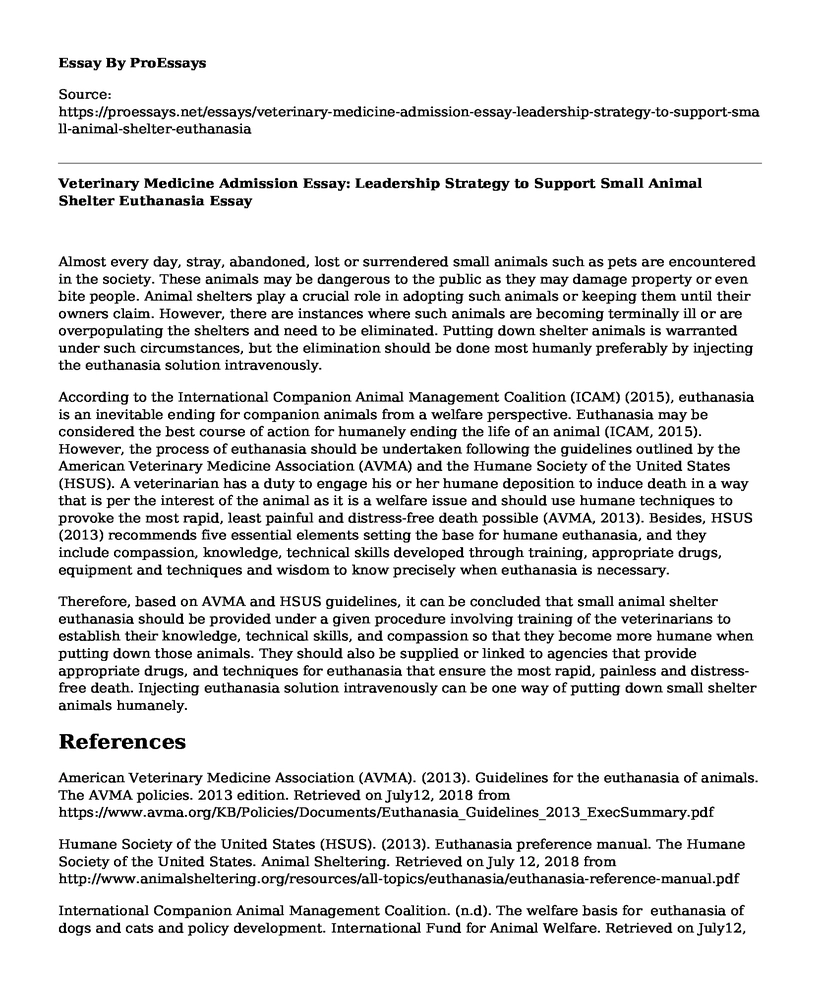Almost every day, stray, abandoned, lost or surrendered small animals such as pets are encountered in the society. These animals may be dangerous to the public as they may damage property or even bite people. Animal shelters play a crucial role in adopting such animals or keeping them until their owners claim. However, there are instances where such animals are becoming terminally ill or are overpopulating the shelters and need to be eliminated. Putting down shelter animals is warranted under such circumstances, but the elimination should be done most humanly preferably by injecting the euthanasia solution intravenously.
According to the International Companion Animal Management Coalition (ICAM) (2015), euthanasia is an inevitable ending for companion animals from a welfare perspective. Euthanasia may be considered the best course of action for humanely ending the life of an animal (ICAM, 2015). However, the process of euthanasia should be undertaken following the guidelines outlined by the American Veterinary Medicine Association (AVMA) and the Humane Society of the United States (HSUS). A veterinarian has a duty to engage his or her humane deposition to induce death in a way that is per the interest of the animal as it is a welfare issue and should use humane techniques to provoke the most rapid, least painful and distress-free death possible (AVMA, 2013). Besides, HSUS (2013) recommends five essential elements setting the base for humane euthanasia, and they include compassion, knowledge, technical skills developed through training, appropriate drugs, equipment and techniques and wisdom to know precisely when euthanasia is necessary.
Therefore, based on AVMA and HSUS guidelines, it can be concluded that small animal shelter euthanasia should be provided under a given procedure involving training of the veterinarians to establish their knowledge, technical skills, and compassion so that they become more humane when putting down those animals. They should also be supplied or linked to agencies that provide appropriate drugs, and techniques for euthanasia that ensure the most rapid, painless and distress-free death. Injecting euthanasia solution intravenously can be one way of putting down small shelter animals humanely.
References
American Veterinary Medicine Association (AVMA). (2013). Guidelines for the euthanasia of animals. The AVMA policies. 2013 edition. Retrieved on July12, 2018 from https://www.avma.org/KB/Policies/Documents/Euthanasia_Guidelines_2013_ExecSummary.pdf
Humane Society of the United States (HSUS). (2013). Euthanasia preference manual. The Humane Society of the United States. Animal Sheltering. Retrieved on July 12, 2018 from http://www.animalsheltering.org/resources/all-topics/euthanasia/euthanasia-reference-manual.pdf
International Companion Animal Management Coalition. (n.d). The welfare basis for euthanasia of dogs and cats and policy development. International Fund for Animal Welfare. Retrieved on July12, 2018 from http://www.ifaw.org/sites/default/files/ICAM%20Euthanasia%20Protocol.pdf
Cite this page
Veterinary Medicine Admission Essay: Leadership Strategy to Support Small Animal Shelter Euthanasia. (2022, Jan 14). Retrieved from https://proessays.net/essays/veterinary-medicine-admission-essay-leadership-strategy-to-support-small-animal-shelter-euthanasia
If you are the original author of this essay and no longer wish to have it published on the ProEssays website, please click below to request its removal:
- Questions and Answers on Mobility - Paper Example
- The VA Medicinal Cannabis Research Act (2018) Essay Example
- GPR Resident at Al Karama Dental Center: Experiences in Orthodontics and Orthognathic Surgery
- Essay Sample on Teenage Pregnancy: A Journey of Pain, Anger and Resentment
- Coronavirus Outbreak: Impact on U.S. and European Stocks - Essay Sample
- Essay Sample on Benign Prostatic Hyperplasia: A Common Prostate Gland Enlargement in Men
- Essay Example on Nursing Professionalism: The Characteristics That Matter







